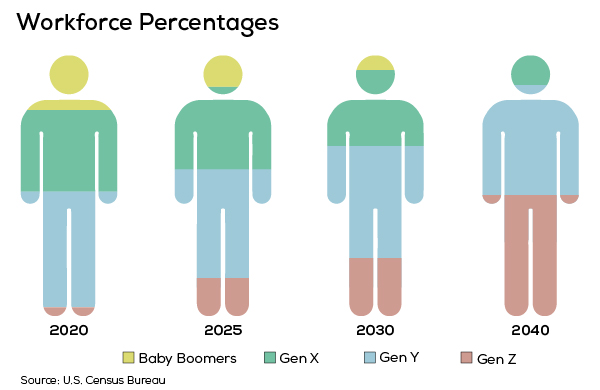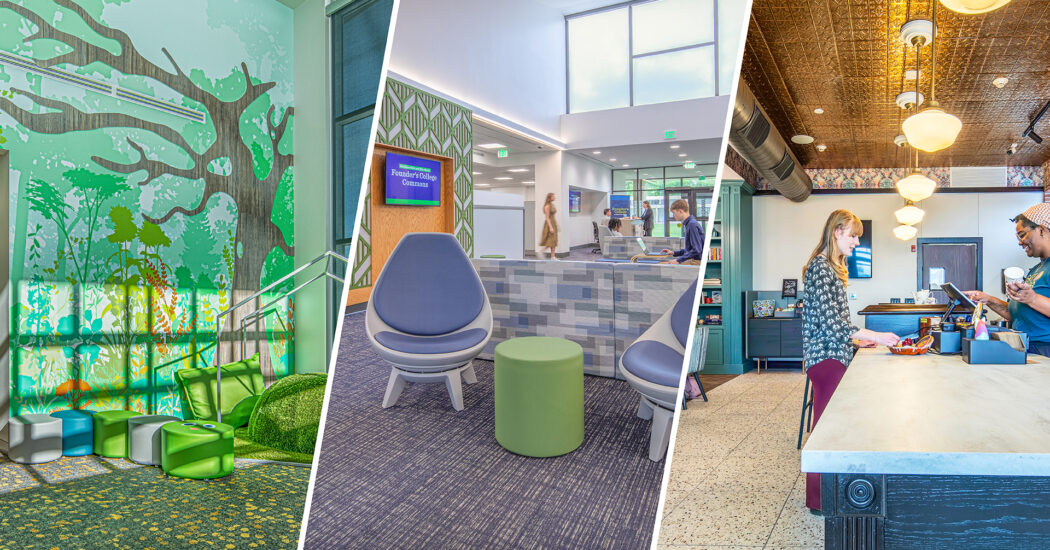Designing for Generation Z
-
Category
Studio-Workplace, Studio-Lifestyle, Studio-Community, Innovation -
Posted By
Sarah Hempstead -
Posted On
May 01, 2019
Generation Z, the 60-some million young people born between the late 1990s and early 2000s, are the most diverse group in our country’s history.
They grew up during times of recessions and financial crises, war and terror threats, and technology overload. Many of them knew how to operate a tablet or cellphone before they could put sentences together. They don’t remember a life without social media and spend up to nine hours a day consuming media. They have a rather short attention span and it can be difficult to keep them engaged. In the next ten years, it is estimated that Gen Z will consist of 22% of the workforce and many will be working in jobs that don’t even exist yet.

According to the Wall Street Journal, “Gen Z workers are more competitive and pragmatic, but also more anxious and reserved, than millennials, the generation of 72 million born from 1981 to 1996, according to executives, managers, generational consultants and multidecade studies of young people.”
Learning how to design for Generation Z will be essential in the longevity of our communities, facilities, and workplaces. So, what design features will help attract and retain this large cohort?
Choice and Input
It’s easy: let them be a part of the design process, ask them to give input on what they want and expect, and then simply listen to what they have to say. One of the easiest ways to connect with this generation is through making them feel like their voices are heard. Designers can bring them idea starters and guidelines to get conversation going but try to immerse yourself into their world if you want a truly successful project. You can do this through focus groups, community engagement events, social media polls, and project blogs/websites.
Of special note, long-term choice is essential. Design should allow for variation over the life of a building, allowing the space to be tailored to each user’s preferences:
- Robust power – consider a raised floor
- Expansive wi-fi
- Furniture that is movable – think everything on wheels, closable pods, and sitting/standing desks
Technology-Rich Spaces
As the baby boomers are retiring and Gen Z starts to fill in the gaps, technology will follow them. The places they live, work, and play need to reflect a lifestyle they are accustomed to: attached to hand-held supercomputers which provide instant communication with others. This diverse and mobile group will crave a digital connection to the world. In terms of the workplace, an office setting should include technology that will seamlessly allow staff to work from home (or a coffee shop across the world) but also enhanced video conferencing from anywhere. With good lighting and acoustics along with the ability to easily share documents and control, the office can be anywhere.
As designers, we need to think of technology that will help the facilities operate longer yet efficiently. Because Gen Z is predicted to put in a lot of hours in the office, the building systems will need to run differently than the regular 8-5pm. Allowing small spaces to be controlled and operated as needed without requiring the entire facility to be in operation will result in lower energy costs.
Gen Z Values Flexibility
This generation works really hard, but they want some playtime as well. If you are going to create a flexible work environment, including staff who work remotely, creating a gathering space is essential for retention and overall job satisfaction. One design idea is to create a comfortable commons area filled with homey furniture, a coffee bar, and plenty of natural light. This type of space will allow Gen Z workers to take a brain break and socialize before getting back to the grind. Filling a space with familiar furniture pieces will ease anxiety and gives everyone a space to feel connected to peers.
We don’t all work the same, and an office won’t likely be comprised solely of Gen Z’ers. Design a workplace that has multiple types of rooms with varying functionality and privacy. If you can handle working in an open concept area, great! If you also need to get away from the hustle and bustle to really concentrate, great! If you need that ability to meet with a couple team members for a quick collaboration session away from your desks, great! If you need to meet with several people from around the office and need a more formal setting with technology, that’s great too!
Genuine Feel
This is a big one to keep in mind when you are looking to put your roots down for a new project. This generation gravitates toward places, people, and things that feel real, predictable, and safe. If you are wanting to attract and retain the Generation Z population, start by looking for a location that has its own sense of culture. Your building or space should come from and build on its history and the community naturally. Furthermore, your space should promote general well-being for users. Historic areas and neighborhoods are a big hit with this generation, leaving a lot of good potential for adaptive reuse projects. Staying true to the story makes the work resonate – do not to cut out the charm of the old while designing the new. The pre-packaged, Instagram filter world has ended, and Generation Z is seeking a genuine experience.
Choosing a location that is walkable and bikeable with nearby restaurants and attractions, grocery stores, and hotels will draw in more people. This goes for any type of building in the urban mix, from office space to apartments to mixed-use developments.
Once you have a location, make sure to include biophilic design features that promote happiness and health. Generation Z is very conscious of their mental and physical health—promoting that connection back to nature within a building will relate well with those users.
Inclusivity
Generation Z is a beautiful ethnically diverse population, which is important to keep in mind when designing communities and buildings for them. Not everyone experiences a space the same, in part due to their culture and all that comes along with their unique backgrounds. Connecting back to “choice and input”, you will get the information that you need to ensure a space is inclusive if Gen Z’ers are included in the process.
It is time to prepare and adapt for future generations, allowing their influences to permeate through the built environment to stay relevant and competitive in the world. We should admire and enhance their creativity, empathetic attitudes, desire to feel connection, and heads-down work mentality with the spaces we provide. With the help of Generation Z, we should create communities and spaces that harness that same energy and drive toward success. If you want to more specifics on how to design for Gen Z, give us a call!







